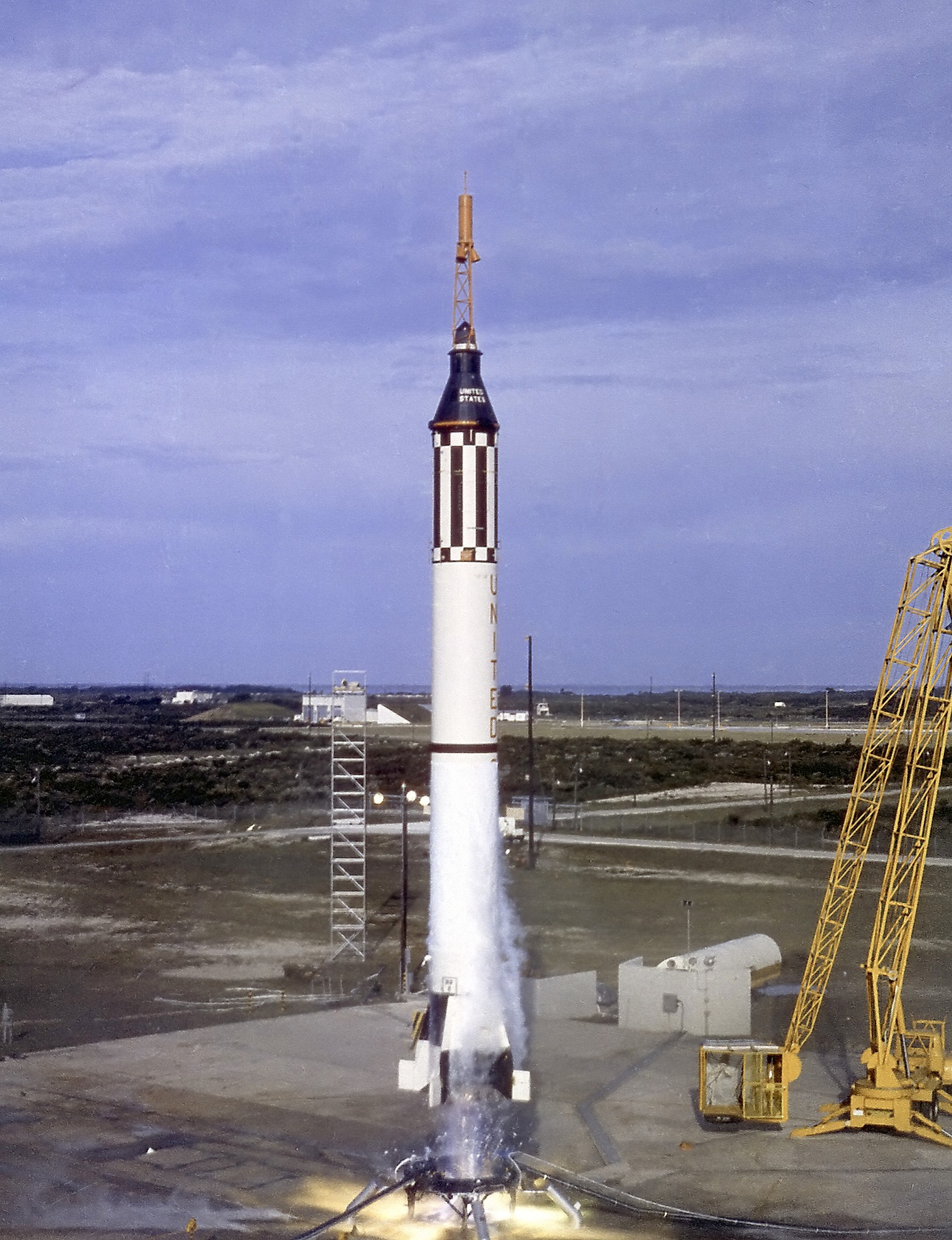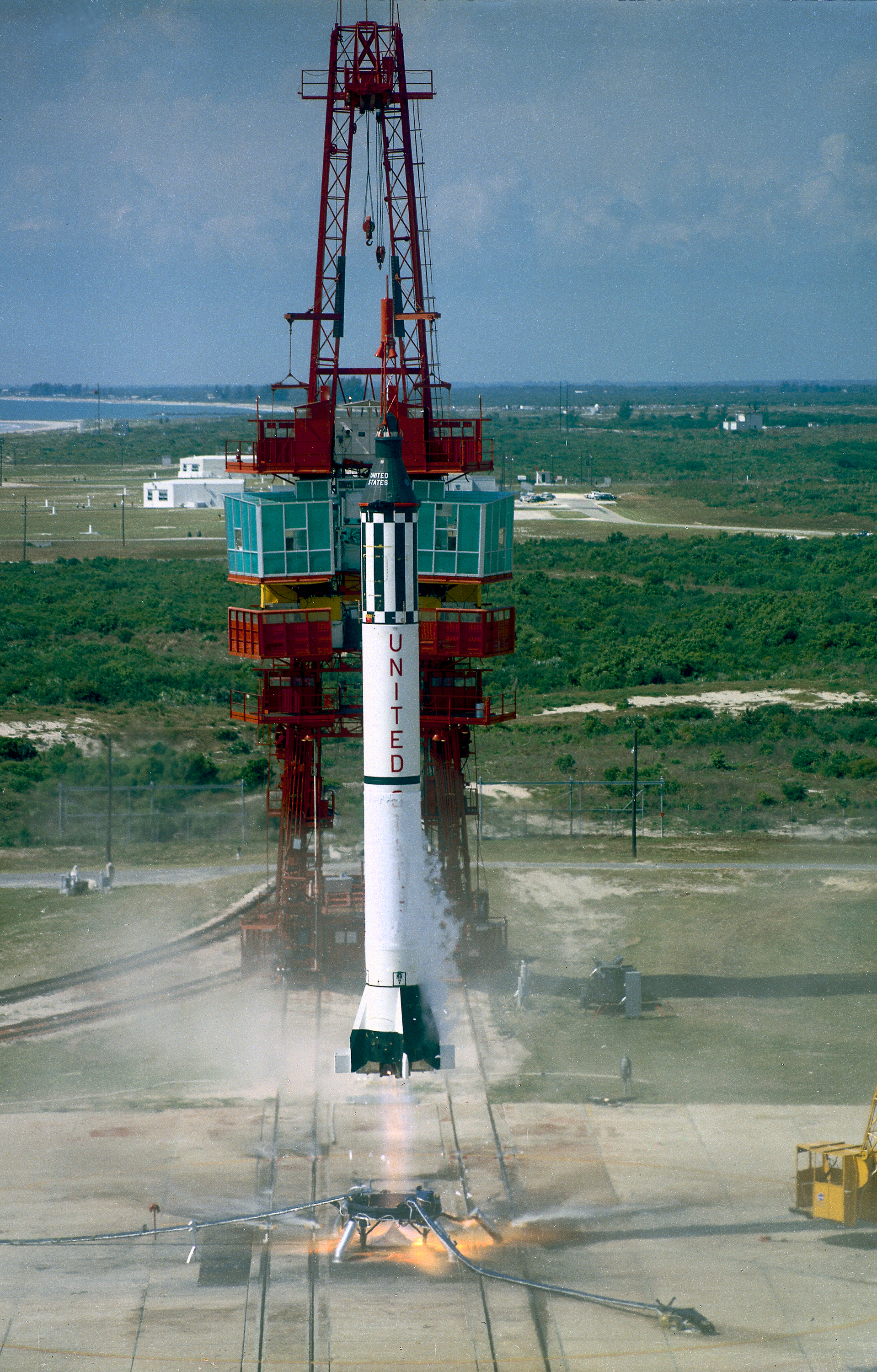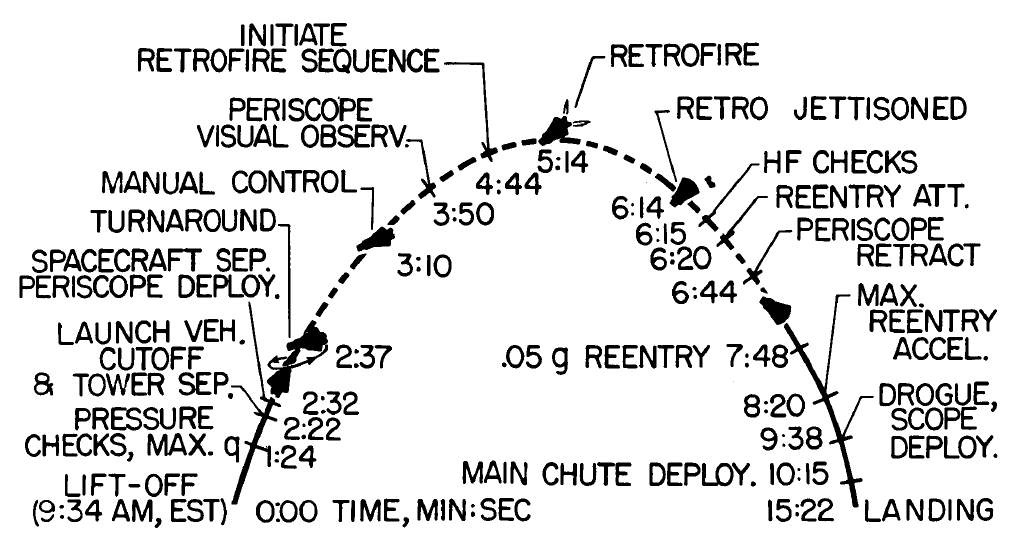|
MR-4
Mercury-Redstone 4 was the second United States human spaceflight, on July 21, 1961. The suborbital Project Mercury flight was launched with a Mercury-Redstone Launch Vehicle, MRLV-8. The spacecraft, Mercury capsule #11, was nicknamed the ''Liberty Bell 7''. It was piloted by astronaut Virgil "Gus" Grissom. The spaceflight lasted 15 minutes 30 seconds, reached an altitude of more than , and flew downrange, landing in the Atlantic Ocean. The flight went as expected until just after splashdown, when the hatch cover, designed to release explosively in the event of an emergency, accidentally blew. Grissom was at risk of drowning, but was recovered safely via a U.S. Navy helicopter. The spacecraft sank into the Atlantic and was not recovered until 1999. Mission parameters * Mass: 1 286 kg * Maximum altitude: 190.39 km * Range: 486.15 km * Launch vehicle: Redstone rocket Spacecraft The MR-4 spacecraft, Mercury capsule #11, was designated to fly the second crewe ... [...More Info...] [...Related Items...] OR: [Wikipedia] [Google] [Baidu] |
Mercury-Redstone Launch Vehicle
The Mercury-Redstone Launch Vehicle, designed for NASA's Project Mercury, was the first American crewed space booster. It was used for six sub-orbital Mercury flights from 1960–1961; culminating with the launch of the first, and 11 weeks later, the second American (and the second and third humans) in space. The four subsequent Mercury human spaceflights used the more powerful Atlas booster to enter low Earth orbit. A member of the Redstone rocket family, it was derived from the U.S. Army's Redstone ballistic missile and the first stage of the related Jupiter-C launch vehicle; but to human-rate it, the structure and systems were modified to improve safety and reliability. Modifications from the Redstone missile NASA chose the U.S. Army's Redstone liquid-fueled ballistic missile for its sub-orbital flights as it was the oldest one in the US fleet, having been active since 1953 and had many successful test flights.''The Mercury-Redstone Project'', p. 2-2, 3-1. The s ... [...More Info...] [...Related Items...] OR: [Wikipedia] [Google] [Baidu] |
Cape Canaveral Air Force Station Launch Complex 5
Cape Canaveral Launch Complex 5 (LC-5) was a launch site at Cape Canaveral Space Force Station, Florida used for various Redstone and Jupiter launches. It is most well known as the launch site for NASA's 1961 suborbital Mercury-Redstone 3 flight, which made Alan Shepard the first American in space. It was also the launch site of Gus Grissom's July, 1961, Mercury-Redstone 4 flight. The Mercury-Redstone 1 pad abort, Mercury-Redstone 1A, and the January, 1961, Mercury-Redstone 2 with a chimpanzee, Ham, aboard, also used LC-5. A total of 23 launches were conducted from LC-5: one Jupiter-A, six Jupiter IRBMs, one Jupiter-C, four Juno Is, four Juno IIs and seven Redstones. The first launch from the complex was a Jupiter-A on July 19, 1956 and the final launch was Gus Grissom's ''Liberty Bell 7'' capsule on July 21, 1961. LC-5 is located next to the Air Force Space and Missile Museum which is located at LC-26. The original launch consoles and computers are on display in the LC-5 bloc ... [...More Info...] [...Related Items...] OR: [Wikipedia] [Google] [Baidu] |
Freedom 7
Mercury-Redstone 3, or ''Freedom 7'', was the first United States human spaceflight, on May 5, 1961, piloted by astronaut Alan Shepard. It was the first crewed flight of Project Mercury. The project had the ultimate objective of putting an astronaut into orbit around the Earth and returning him safely. Shepard's mission was a 15-minute suborbital flight with the primary objective of demonstrating his ability to withstand the high g-forces of launch and atmospheric re-entry. Shepard named his space capsule ''Freedom 7'', setting a precedent for the remaining six Mercury astronauts naming their spacecraft. The number 7 was included in all the crewed Mercury spacecraft names to honor NASA's first group of seven astronauts. His spacecraft reached an altitude of 101.2 nautical miles (116.5 statute miles, 187.5 km) and traveled a downrange distance of 263.1 nautical miles (302.8 statute miles, 487.3 km). It was the fourth Mercury flight launched with the Mercury-Redstone La ... [...More Info...] [...Related Items...] OR: [Wikipedia] [Google] [Baidu] |
Project Mercury
Project Mercury was the first human spaceflight program of the United States, running from 1958 through 1963. An early highlight of the Space Race, its goal was to put a man into Earth orbit and return him safely, ideally before the Soviet Union. Taken over from the US Air Force by the newly created civilian space agency NASA, it conducted 20 uncrewed developmental flights (some using animals), and six successful flights by astronauts. The program, which took its name from Roman mythology, cost $ (adjusted for inflation). The astronauts were collectively known as the "Mercury Seven", and each spacecraft was given a name ending with a "7" by its pilot. The Space Race began with the 1957 launch of the Soviet satellite Sputnik 1. This came as a shock to the American public, and led to the creation of NASA to expedite existing US space exploration efforts, and place most of them under civilian control. After the successful launch of the Explorer 1 satellite in 1958, crewed spacef ... [...More Info...] [...Related Items...] OR: [Wikipedia] [Google] [Baidu] |
Mercury-Redstone 3
Mercury-Redstone 3, or ''Freedom 7'', was the first United States human spaceflight, on May 5, 1961, piloted by astronaut Alan Shepard. It was the first crewed flight of Project Mercury. The project had the ultimate objective of putting an astronaut into orbit around the Earth and returning him safely. Shepard's mission was a 15-minute suborbital flight with the primary objective of demonstrating his ability to withstand the high g-forces of launch and atmospheric re-entry. Shepard named his space capsule ''Freedom 7'', setting a precedent for the remaining six Mercury astronauts naming their spacecraft. The number 7 was included in all the crewed Mercury spacecraft names to honor NASA's first group of seven astronauts. His spacecraft reached an altitude of 101.2 nautical miles (116.5 statute miles, 187.5 km) and traveled a downrange distance of 263.1 nautical miles (302.8 statute miles, 487.3 km). It was the fourth Mercury flight launched with the Mercury-Redstone Launch ... [...More Info...] [...Related Items...] OR: [Wikipedia] [Google] [Baidu] |
Kilogram
The kilogram (also kilogramme) is the unit of mass in the International System of Units (SI), having the unit symbol kg. It is a widely used measure in science, engineering and commerce worldwide, and is often simply called a kilo colloquially. It means 'one thousand grams'. The kilogram is defined in terms of the second and the metre, both of which are based on fundamental physical constants. This allows a properly equipped metrology laboratory to calibrate a mass measurement instrument such as a Kibble balance as the primary standard to determine an exact kilogram mass. The kilogram was originally defined in 1795 as the mass of one litre of water. The current definition of a kilogram agrees with this original definition to within 30 parts per million. In 1799, the platinum ''Kilogramme des Archives'' replaced it as the standard of mass. In 1889, a cylinder of platinum-iridium, the International Prototype of the Kilogram (IPK), became the standard of the unit of mass for ... [...More Info...] [...Related Items...] OR: [Wikipedia] [Google] [Baidu] |
Ejection Seats
In aircraft, an ejection seat or ejector seat is a system designed to rescue the pilot or other crew of an aircraft (usually military) in an emergency. In most designs, the seat is propelled out of the aircraft by an explosive charge or rocket motor, carrying the pilot with it. The concept of an ejectable escape crew capsule has also been tried. Once clear of the aircraft, the ejection seat deploys a parachute. Ejection seats are common on certain types of military aircraft. History A bungee-assisted escape from an aircraft took place in 1910. In 1916, Everard Calthrop, an early inventor of parachutes, patented an ejector seat using compressed air. The modern layout for an ejection seat was first introduced by Romanian inventor Anastase Dragomir in the late 1920s. The design featured a ''parachuted cell'' (a dischargeable chair from an aircraft or other vehicle). It was successfully tested on 25 August 1929 at the Paris-Orly Airport near Paris and in October 1929 at Băne ... [...More Info...] [...Related Items...] OR: [Wikipedia] [Google] [Baidu] |
Ham (chimpanzee)
Ham (July 1957 – January 19, 1983), a chimpanzee also known as Ham the Chimp and Ham the Astrochimp, was the first Great Ape launched into space. On January 31, 1961, Ham flew a suborbital flight on the Mercury-Redstone 2 mission, part of the U.S. space program's Project Mercury. Ham's name is an acronym for the laboratory that prepared him for his historic mission—the Holloman Aerospace Medical Center, located at Holloman Air Force Base in New Mexico, southwest of Alamogordo. His name was also in honor of the commander of Holloman Aeromedical Laboratory, Lieutenant Colonel Hamilton "Ham" Blackshear. Early life Ham was born in July 1957 in French Cameroon (now Cameroon), captured by animal trappers and sent to the Rare Bird Farm in Miami, Florida. He was purchased by the United States Air Force and brought to Holloman Air Force Base in July 1959. There were originally 40 chimpanzee flight candidates at Holloman. After evaluation, the number of candidates was reduced ... [...More Info...] [...Related Items...] OR: [Wikipedia] [Google] [Baidu] |
Common Chimpanzee
The chimpanzee (''Pan troglodytes''), also known as simply the chimp, is a species of Hominidae, great ape native to the forest and savannah of tropical Africa. It has four confirmed subspecies and a fifth proposed subspecies. When its close relative the bonobo was more commonly known as the pygmy chimpanzee, this species was often called the common chimpanzee or the robust chimpanzee. The chimpanzee and the bonobo are the only species in the genus Pan (genus), ''Pan''. Evidence from fossils and DNA sequencing shows that ''Pan'' is a sister taxon to the Human evolution, human lineage and is humans' closest living relative. The chimpanzee is covered in coarse black hair, but has a bare face, fingers, toes, palms of the hands, and soles of the feet. It is larger and more Robustness (morphology), robust than the bonobo, weighing for males and for females and standing . The chimpanzee lives in groups that range in size from 15 to 150 members, although individuals travel and forag ... [...More Info...] [...Related Items...] OR: [Wikipedia] [Google] [Baidu] |
Pound (mass)
The pound or pound-mass is a unit of mass used in British imperial and United States customary systems of measurement. Various definitions have been used; the most common today is the international avoirdupois pound, which is legally defined as exactly , and which is divided into 16 avoirdupois ounces. The international standard symbol for the avoirdupois pound is lb; an alternative symbol is lbm (for most pound definitions), # ( chiefly in the U.S.), and or ″̶ (specifically for the apothecaries' pound). The unit is descended from the Roman (hence the abbreviation "lb"). The English word ''pound'' is cognate with, among others, German , Dutch , and Swedish . These units are historic and are no longer used (replaced by the metric system). Usage of the unqualified term ''pound'' reflects the historical conflation of mass and weight. This accounts for the modern distinguishing terms ''pound-mass'' and '' pound-force''. Etymology The word 'pound' and its cognates ultim ... [...More Info...] [...Related Items...] OR: [Wikipedia] [Google] [Baidu] |
NASA
The National Aeronautics and Space Administration (NASA ) is an independent agency of the US federal government responsible for the civil space program, aeronautics research, and space research. NASA was established in 1958, succeeding the National Advisory Committee for Aeronautics (NACA), to give the U.S. space development effort a distinctly civilian orientation, emphasizing peaceful applications in space science. NASA has since led most American space exploration, including Project Mercury, Project Gemini, the 1968-1972 Apollo Moon landing missions, the Skylab space station, and the Space Shuttle. NASA supports the International Space Station and oversees the development of the Orion spacecraft and the Space Launch System for the crewed lunar Artemis program, Commercial Crew spacecraft, and the planned Lunar Gateway space station. The agency is also responsible for the Launch Services Program, which provides oversight of launch operations and countdown management f ... [...More Info...] [...Related Items...] OR: [Wikipedia] [Google] [Baidu] |
Pound-force
The pound of force or pound-force (symbol: lbf, sometimes lbf,) is a unit of force used in some systems of measurement, including English Engineering units and the foot–pound–second system. Pound-force should not be confused with pound-mass (lb), often simply called ''pound'', which is a unit of mass, nor should these be confused with foot-pound (ft⋅lbf), a unit of energy, or pound-foot (lbf⋅ft), a unit of torque. Definitions The pound-force is equal to the gravitational force exerted on a mass of one avoirdupois pound on the surface of Earth. Since the 18th century, the unit has been used in low-precision measurements, for which small changes in Earth's gravity (which varies from equator to pole by up to half a percent) can safely be neglected. The 20th century, however, brought the need for a more precise definition, requiring a standardized value for acceleration due to gravity. Product of avoirdupois pound and standard gravity The pound-force is the product ... [...More Info...] [...Related Items...] OR: [Wikipedia] [Google] [Baidu] |







.jpg)
